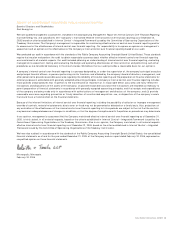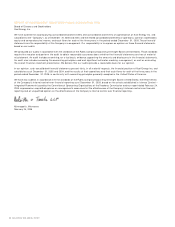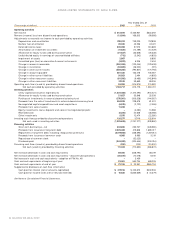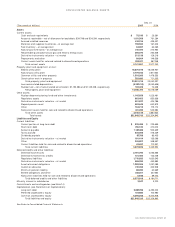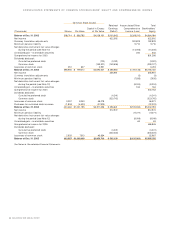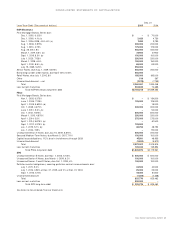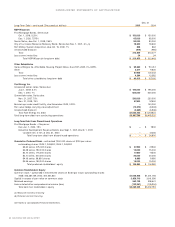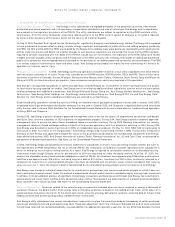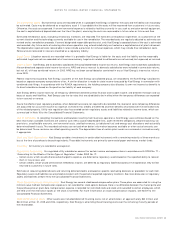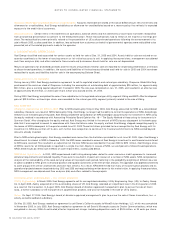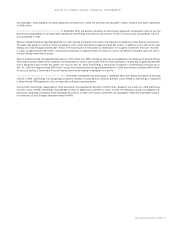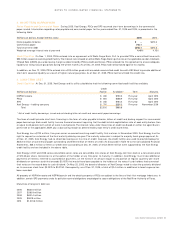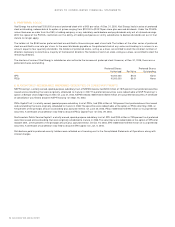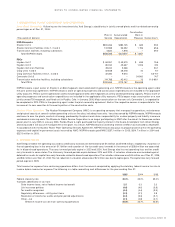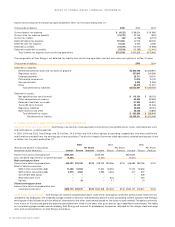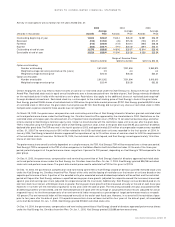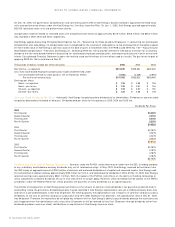Xcel Energy 2005 Annual Report Download - page 50
Download and view the complete annual report
Please find page 50 of the 2005 Xcel Energy annual report below. You can navigate through the pages in the report by either clicking on the pages listed below, or by using the keyword search tool below to find specific information within the annual report.amount collected under the clauses and the recoverable costs incurred. In addition, Xcel Energy presents its revenue net of any excise or
other fiduciary-type taxes or fees. A summary of significant rate-adjustment mechanisms follows:
– NSP-Minnesota’s rates include a cost-of-fuel-and-purchased-energy and a cost-of-gas recovery mechanism allowing dollar-for-dollar recovery
of the respective costs, which are trued-up on a two-month and annual basis, respectively.
– NSP-Wisconsin’s rates include a cost-of-gas adjustment clause for purchased natural gas, but not for purchased electric energy or electric
fuel. In Wisconsin, requests can be made for recovery of those electric costs prospectively through the rate review process, which normally
occurs every two years, and an interim fuel-cost hearing process.
– PSCo generally recovers all prudently incurred electric fuel and purchased energy costs through an electric-commodity adjustment
clause. This fuel mechanism also has in place a sharing among customers and shareholders of certain fuel and energy costs, with an
$11.25 million maximum on any cost sharing over or under an allowed electric-commodity adjustment formula rate, and a sharing among
shareholders and customers of certain gains and losses on trading margins.
– In Texas, SPS may request periodic adjustments to provide electric fuel and purchased energy cost recovery. In New Mexico, SPS has a
monthly fuel and purchased power cost-recovery factor.
– In Colorado, PSCo operates under an electric performance-based regulatory plan, which provides for an annual earnings test in which earnings
above the authorized return on equity are refunded to customers. NSP-Minnesota and PSCo operate under various service standards in
Minnesota and Colorado, respectively, which could require customer refunds if certain criteria are not met. NSP-Minnesota and PSCo’s
rates in Minnesota and Colorado, respectively, also include monthly adjustments for the recovery of conservation and energy-management
program costs, which are reviewed annually.
– NSP-Minnesota, NSP-Wisconsin, PSCo and SPS sell firm power and energy in wholesale markets, which are regulated by the FERC. Certain
of these rates include monthly wholesale fuel cost-recovery mechanisms.
Commodity Trading Operations
All applicable gains and losses related to commodity trading activities, whether or not settled physically,
are shown on a net basis in the Consolidated Statements of Operations.
Xcel Energy’s commodity trading operations are conducted by NSP-Minnesota, PSCo and SPS. Commodity trading activities are not associated
with energy produced from Xcel Energy’s generation assets or energy and capacity purchased to serve native load. Commodity trading contracts
are recorded at fair market value in accordance with SFAS No. 133, as amended. In addition, commodity trading results include the impact
of any margin-sharing mechanisms.
Derivative Financial Instruments
Xcel Energy and its subsidiaries utilize a variety of derivatives, including commodity forwards, futures
and options, index or fixed price swaps and basis swaps, to mitigate market risk and to enhance its operations. For further discussion of
Xcel Energy’s risk management and derivative activities, see Note 12 to the Consolidated Financial Statements.
Property, Plant and Equipment and Depreciation
Property, plant and equipment is stated at original cost. The cost of plant includes
direct labor and materials, contracted work, overhead costs and applicable interest expense. The cost of plant retired is charged to accumulated
depreciation and amortization. Removal costs associated with regulatory obligations are recorded as regulatory liabilities. Significant additions
or improvements extending asset lives are capitalized, while repairs and maintenance are charged to expense as incurred. Maintenance and
replacement of items determined to be less than units of property are charged to operating expenses. Property, plant and equipment also
includes costs associated with property held for future use.
Xcel Energy determines the depreciation of its plant by using the straight-line method, which spreads the original cost equally over the plant’s
useful life. Depreciation expense, expressed as a percentage of average depreciable property, was approximately 3.2 percent, 3.1 percent and
3.0 percent for the years ended Dec. 31, 2005, 2004 and 2003, respectively.
Allowance for Funds Used During Construction (AFDC)
AFDC represents the cost of capital used to finance utility construction activity.
AFDC is computed by applying a composite pretax rate to qualified construction work in progress. The amount of AFDC capitalized as a utility
construction cost is credited to other nonoperating income (for equity capital) and interest charges (for debt capital). AFDC amounts capitalized
are included in Xcel Energy’s rate base for establishing utility service rates. In addition to construction-related amounts, AFDC also is recorded
to reflect returns on capital used to finance conservation programs in Minnesota.
Decommissioning
Xcel Energy accounts for the future cost of decommissioning, or retirement, of its nuclear generating plants through
annual depreciation accruals using an annuity approach designed to provide for full rate recovery of the future decommissioning costs. The
decommissioning calculation covers all expenses, including decontamination and removal of radioactive material, and extends over the estimated
lives of the plants. The calculation assumes that NSP-Minnesota and NSP-Wisconsin will recover those costs through rates. The fair value of
external nuclear decommissioning fund investments are estimated based on quoted market prices for those or similar investments. Unrealized
gains or losses are deferred as regulatory assets or liabilities. For more information on nuclear decommissioning, see Note 15 to the Consolidated
Financial Statements.
PSCo also previously operated a nuclear generating plant, which has been decommissioned and was repowered using natural gas. PSCo’s
costs associated with decommissioning were deferred and amortized consistent with regulatory recovery. These costs were fully recovered
through rates in July 2005.
Nuclear Fuel Expense
Nuclear fuel expense, which is recorded as the nuclear generating plants use fuel, includes the cost of fuel used in
the current period, as well as future disposal costs of spent nuclear fuel. In addition, nuclear fuel expense includes fees assessed by the DOE
for NSP-Minnesota’s portion of the cost of decommissioning the DOE’s fuel-enrichment facility.
48 XCEL ENERGY 2005 ANNUAL REPORT
NOTES TO CONSOLIDATED FINANCIAL STATEMENTS



